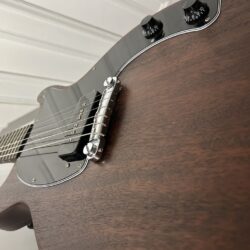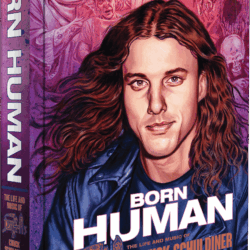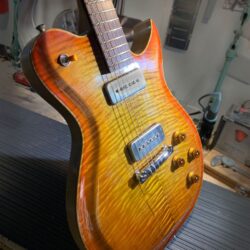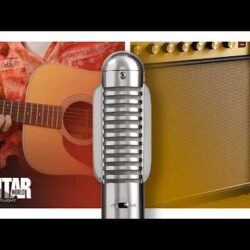
Feelings vs. Physics: What Matters Most for Electric Guitar Tone?
Hello, and welcome back to Mod Garage. After we had a general look at electric guitar “tonewood” last month, we will pick up where we left off to see how important wood is for the sound of an electric guitar, and if everything you can hear when playing it unplugged is present in its amplified tone.I already spoiled the answer in the last part by saying that it’s not the most important factor, and that the correct question to ask is, “How much of what is audible in the unplugged, or primary, sound will be present in the amplified tone?” To be clear, I didn’t say that the wood has no influence on the electrified tone, and that all electric guitars sound the same. To cut to the chase, here is my formula on this, based on proven physics as well as several decades of expertise: The more solidly an electric guitar is built, the less influence its structure has on the amplified tone. We can invert this thinking, too: The more an electric guitar has the qualities of an acoustic guitar, the greater the influence its primary structure will have through an amp.This is not my original wisdom, but is based on decades of intensive scientific research by Professor Manfred Zollner from the German Regensburg University, which mostly matches my experiences from many years in the business. Professor Zollner developed this headnote approximately 15 years ago, and in my opinion, it’s the closest thing to the truth. His actual theory is that the wooden structure of an electric guitar has close to zero influence on the electrified tone.Let’s form a few groups according to different construction methods, which can give us some basic guidelines.Group No. 1: Electric guitars with a set neck and no tremoloThis is the most solidly built family, with guitars like the Gibson Les Paul, SG, LP Junior, etc. and their offshoots from other companies, but also guitars like the PRS McCarty family. Brace yourself: On these guitars, the primary structure has almost no influence on the amplified tone. Yes, mahogany is lightweight, and a flamed maple top looks stunning, but these qualities don’t impact how they sound through a Marshall stack.Group No. 2: Electric guitars with a set neck and tremoloThe next most densely constructed guitars include the Gibson Les Paul Axcess and Firebird, the Gretsch Jet, the PRS Custom and Standard family, a lot of Ibanez guitars, etc. Here, the body mass does a bit more to the tone; later, we will discover why this is.Group No. 3: Electric guitars with a bolt-on neck and no tremoloHere, we have the grandfathers of all electric guitars: the Fender Telecaster and Esquire, but also hardtail Stratocaster models along with the Mustang and Duo Sonic, PRS’ NF53, and many more.Group No. 4: Electric guitars with a bolt-on neck and tremoloThe classic Fender Stratocaster comes to mind, along with the Jaguar and Jazzmaster, the PRS CE family, and a lot of Gretsch guitars.Group No. 5: Semi-hollowbody and chambered electric guitarsThis collection includes instruments from the first group that lean more towards the construction of an acoustic guitar, with guitars like the Gibson ES-335, Gretsch and PRS semi-hollowbody models, the Fender Thinline Telecaster, Coronado, and Starcaster, and countless other models. Applying the guidelines from above, we also have to differentiate based on set versus bolt-on neck, as well as inclusion of tremolo.Group No. 6: Hollowbody electric guitarsIn this last section, we have the “big boys” that are usually referred to as jazz guitars or archtops, like the Gibson Byrdland, Super 400, L5, the Epiphone Broadway, Ibanez George Benson, etc. These are more or less acoustic guitars with pickups, and compared to all the other categories, their primary construction has the most significant effect on the amplified tone.So far, I bet a lot of you will be cursing my name. I know that playing and expressing oneself with the guitar are highly emotional things, and I’m not taking exception with this. But you can’t bargain with the hard facts of physics—if you drop a glass of wine, it will hit the floor, not the ceiling, at least on Earth.Let me explain. First and foremost, woods are for stability, surface feel, and optical appearance on electric guitars. They create a certain feeling, but don’t really change the instrument’s electrified tone. This is the point where we are all humans with emotions, prone to psychoacoustics, conclusions by analogy, and of course, confirmation bias. We see a guitar with a bright maple neck, so we expect a bright tone. We have a dark rosewood or ebony fretboard, so we expect a dark tone. You get the idea.You all know the saying that the tone is in the fingers, and this hits the nail on the head for electric guitars. The tonal influence of the individual playing style of each guitarist is much more powerful than the subtle differences of wood selection. Playing style is also never perfectly consistent, no matter if you are a beginner or pro player. It’s close to impossible to exactly reproduce picking strength, location, and velocity, and these things alone create much more tonal difference than the wood with which a guitar is built.Here’s a story to illustrate the point; you may have heard it before. German guitarist Paul Vincent, who passed in 2016, was one of the best guitar players worldwide, and the studio guitarist for Freddie Mercury during his solo phase without Queen. You can hear his playing on Mercury’s Mr. Bad Guy on hits like “Living On My Own” and “I Was Born to Love You.” These hits were recorded in the Musicland Studios in Munich, Vincent’s hometown. In his Rock Guitar Book from 1993, he describes meeting Brian May at Musicland in 1985 during the recording of the Queen single “One Vision.” After Brian finished his overdub, he walked out of the studio to greet Paul, handed his Red Special guitar over to him, and said, “Go ahead, play a little for me, I want to see your left hand vibrato.” Paul was speechless and totally blindsided, but also full of curiosity and respect. He was holding the original Red Special in his hands, plugged into the famous Deacy Amp and everything else May was using in the studio. But when he started playing, he simply sounded like Paul Vincent, and not even close to Brian May, even when hitting some famous Queen licks and riffs.I think that says it all. Vincent was looking for an escape hatch from this situation, so he handed Red Special back to May, telling him that studio time is expensive and he didn’t want to take up his afternoon. May smiled at him and said, “You are an outstanding player, Paul.”With that settled, next month, we will start to work on our cheap budget guitar, parsing out what really influences the amplified tone of an electric guitar, step-by-step, so stay tuned!Until then … keep on modding!
Read more »
Pre-Order ‘Born Human: The Life and Music of DEATH’s CHUCK SCHULDINER’ from Decibel Books! Read an Exclusive Excerpt Now!
Pre-order the massive, nearly 500-page official biography of death metal pioneer Chuck Schuldiner from Decibel Books and read an excerpt now!
The post Pre-Order ‘Born Human: The Life and Music of DEATH’s CHUCK SCHULDINER’ from Decibel Books! Read an Exclusive Excerpt Now! appeared first on Decibel Magazine.

Headless comfort, but with a headstock? Kiesel Kyber walk-through and demo
Sleek, ergonomic and built for serious performance, the Kiesel Kyber is the brand’s most forward-thinking guitar to date. The Kyber weighs less than 6 lbs. and is packed with pro-level…
Read more »
Robert Keeley: From Homemade Mods to Pedal Powerhouse
Long before boutique pedals took over the world, Robert Keeley was there. Growing up in a musical family with a long line of electrical engineers sparked a circuit-bending obsession with tone. It wasn’t long before young Keeley was modding existing pedals, adding switching options inspired by high-end car audio equipment. This unique approach laid the groundwork for what would become one of the most respected brands in guitar effects: Keeley Electronics. Starting with celebrated platforms like the Boss Blues Driver and Ross Compressor, Keeley’s early mods—namely, the Super Phat Mod overdrive and his flagship Keeley Compressor—became icons. Nearly 25 years ago, his overdrive and compressor were seemingly everywhere, overnight. Even guitar royalty got in on the action.“It didn’t take very long,” Keeley admits, explaining the ignition of his initial overdrive box. “One time, Dave Weiner [former Steve Vai rhythm guitarist] said, ‘Steve has some DS-1s he wants you to mod.’ I said, ‘Send them my way!’ I called it the Ultra Mod after his album, Alive in an Ultra World.”Unfortunately, success also brought challenges. For Keeley, the early years of the boutique boom were clouded by addiction, loss, and hard lessons that would sink most small builders. While competition was springing up everywhere, he was losing his marriage, his health, and his company’s momentum.Yet if there’s one thing this story makes clear, it’s that Keeley refuses to go quietly. What emerged from the darkness wasn’t just a revitalized company; it was a new era. Today, Keeley Electronics, which employs 35 people, is an industry leader. And through it all, Robert Keeley’s joyful and passionate outlook still permeates everything he says and does.In this conversation, Keeley opens up about surviving life’s boom and bust cycles, the freedom of keeping everything in-house, and how Phish’s Trey Anastasio inspired both his first compressor and most recent Manis overdrive. Your compressor seemed like an overnight success. What was it like rocketing from “I want to try modding pedals” to suddenly being the Compressor Guy?It was a whirlwind. I was working at a stereo store repairing high-end audio gear when I found out Trey Anastasio used a thing called a Ross Compressor. I looked on eBay, and they were $400 each. There was no way I could afford that, so I bought the parts and made it myself. “I think pedals will be around for a very long time. They’re the quickest, cheapest way to get inspiration between your guitar and amp.”I was following [guitar electronics guru] R.G. Keen’s articles about the Ross Compressor. He’d explain circuits and offer little tips, like when Ross improved the power supply with an extra capacitor and resistor. I’d think, “What if I make it even better? If I use stronger transistors and tweak the circuit, I’d get a better compression sound.” Once I heard it, I thought, “This is amazing.” I put one up on eBay to sell and used that sale to buy more parts. Your pedal mods, like those on the Blues Driver, were also massive hits. What got you into working with pre-existing pedals?Well, I also wanted to capture the sounds of the Tube Screamer Trey was using. And for me, it’s always been, “What if I [swap components], combine them, and solve some tone problems at the same time?” So I looked at all the complaints on Harmony Central—“not enough bass, tone control doesn’t work, needs more gain, needs less gain”—and made mods that solved most of those complaints. I was also like, “Man, I could do some mods like I see on car stereos, where they have a little switch for a bass boost.” And that’s how I did it in the beginning.Those Blues Driver and Tube Screamer mods eventually became the Keeley Super Phat Mod and Red Dirt, but why did it take so long to release them as your own pedals?I didn’t want to just copy something to make my own drives. I still had an ego. I didn’t want to just say, “Here’s my modded Tube Screamer.” But when you get in trouble with the IRS and have to pay $13,000 a month in alimony, you’ll do a lot for money, including putting out a pedal called the Red Dirt. [laughs] I had to punch like a businessman. Besides, I couldn’t start a business with just one pedal, and people got tired of “the Compressor Guy.”“Everyone told me, ‘Just declare bankruptcy.’ That was the last thing I was going to do.”You’ve been very open about a lot of your early struggles. But while that can derail a lot of small businesses, you’ve always found a way to overcome. Why do you think that is?I developed that during my divorce. I was so high on pills that I wasn’t paying taxes. My wife was embezzling $170,000 a year and not reporting it. Then she hired attorneys for an alimony case, so I had to pay back a quarter million to the IRS, and owed a million in alimony and child support. Everyone told me, “Just declare bankruptcy.” That was the last thing I was going to do. When you’re dealt that kind of news—and won’t give up—you think, “I need to sell pedals by Friday to make payroll!” It was survival.You definitely survived—and thrived. The 2000s through 2020 were huge years for pedal companies, and it seemed like every release you put out was a hit. What was that period like for you?It was really fascinating because in those early years my sales doubled. It seemed like anything I made would sell itself. I was also bringing all the processes back in-house. My shop had burned in 2009, so all my cases were being drilled and powder-coated elsewhere, and then printed by another firm. I was bringing things back in-house and having to learn how to do everything again. But I get endless lucky breaks. [Keeley signature artist] Andy Timmons came on at the right time; that guy can move gear like nobody’s business. And we just got to the next level in our DSP.“Trey Anastasio’s tech texted me and said, ‘It’s the perfect time to send Trey a bunch of your Klon ideas.’”Speaking of DSP [digital signal processing], you’ve grown far beyond compressors. What led you down the digital path?It’s the people around me. My wife’s son, Craighton [Hale, Keeley Electronics engineer], was going to school for electrical engineering, so we had an electronics-minded person working with me. And our longest-running employee, Aaron Tackett, got tired of CNC work. I said, “How would you like to learn programming and help me with DSP?” He said, “Yeah, okay, I’ll do that.” And my god, did he take after it! I love setting people up for things. I’ve been fortunate to have enough business coming in to pay these people well while they learn. Then they become superstars.You share the spotlight with your team, have someone cooking for them, and give them a four-day workweek while still paying for 40 hours. That’s not something many employers offer.I just like being nice. They thought free lunch was fine, so I went, “What if we make Thursdays the greatest day ever?” Also, I can’t stand seeing my son-in-law paying over a grand monthly for health care, or employees being afraid of creating families because they can’t afford insurance. So I’m paying 60 percent of their health insurance. And I know how important it is to have three days off to feel human, get business done, and relax. I try to kill them with kindness. One day out of the year I might be demanding and yell, “Get that shit done!” Then I go back to being Santa Claus.You’ve been through a lot over the years. How do you continue to take such pride in your team and the work you do together?It seems like the only right way to do it. I’m always trying to say, “Why are you worrying? Let’s solve the problem so we don’t have to think about bad possibilities.” Besides, no one buys a downer story. But if you say, “I’m so proud of this pedal I designed,” people get interested. Keeley Electronics seems to be entering a new era—your pedals have a fresh, more modern look, and you’re combining digital and analog in innovative ways. What’s inspiring this approach?What started this wave was the freedom to expand our ideas and get out of the silly Chinese, prefab enclosures. Around 2020, I thought, “What machine can I buy to make them here?”Now, having our own cases lets us design how we want. We developed this thing where I can put two circuit boards in there. The Noble Screamer was our first pedal like that. We could never have fit that in a standard box. Now I’ve got a prototype for next year—the Stereo Caverns—with delay, reverb, MIDI, expression pedal, stereo in and out, and presets. It’s all in there. That freedom started this wave. “If I hadn’t had the success of the Octa Psi, I would be darn-near crying in my beer. But that’s the story of my life! I’m very fortunate.”You do much more than just build enclosures. How did you evolve into a vertically integrated operation, managing so many parts of the production process in-house?Every time the court system or the IRS would say I had to pay something else, I couldn’t get any credit with my suppliers. So, I would bring the whole procedure back in. I’d get a loan-shark-type loan for a powder coating thing or a CNC machine, and just sit down with my guys and ask them to figure it out. It’d take, sometimes, a couple of years to figure out how to do a process, but eventually I built everything. Now we have four UV LED printers. We have four CNCs. I have a 3-kilowatt fiber laser. I have a CNC press brake. I have two powder coating booths, ovens, and spray booths. You just take it one piece at a time. You buy this equipment, and you know, “In about two years, I’ll pay it off, and I won’t be dependent on anyone anymore.”Doing so much in-house probably insulates you to some extent, but how are tariffs and the changing market affecting the company?I have to admit that last year things really slowed down for me during the summer. And if I hadn’t had the success of the Rotary pedal and our Zoma reverb, it would have been very, very scary. And then, as we rolled into this new year, the tariffs have been very expensive. If I hadn’t had the success of the Octa Psi, I would be darn near crying in my beer. But that’s the story of my life! I’m very fortunate. Also, I put all my eggs into the DSP basket. It really paid off, because it’s very hard to do that stuff. I’ve got my spectrum analyzer looking at the smallest minutia of noise and frequency response details. By the time you get back to analog drive pedals, you’re dialed in. Is that what happened with the new Manis overdrive?I can actually tell you how the Manis happened. Justin Stabler, Trey Anastasio’s tech, texted me and said, “It’s the perfect time to send Trey a bunch of your Klon ideas. He wants to audition them.” I said, “I’ll have something in a couple days.” I walked out of my office, went to Craighton, and said, “I want to try Russian germanium transistors and see if they have a different forward voltage than [Klon creator] Bill Finnegan’s germanium diodes.” Craighton had also been working on a bass boost that lets more bass into the clipping section. I said, “Great! Design it up.”We sent two to Trey, and he messaged me saying, “Dang, I tried to go back to a Tube Screamer and I kept wanting the Manis.” Now he’s saying, “I want my first custom signature pedal. I want Keeley to make me a new Boomerang [a popular looper pedal]. I don’t like the new Boomerangs, and the old ones are always breaking on me.” So I’ll spend the next couple years working on that. It’s fun.A couple years means you’re pretty confident in the pedal market, even with everything going on currently. Where do you think things are headed?It’s still the golden age of pedals, but you’ll only have true success if you bring something new to the market. If you’re just saying, “I’m doing the best Tube Screamer,” that ship has sailed. I think pedals will be around for a very long time. They’re the quickest, cheapest way to get inspiration between your guitar and amp. And they’re malleable. You can put this one here, that one there, give it to your friend, get it back, find a video, and try something new. What’s a pedal you’ve always wanted to make, but haven’t yet? Number one is a MIDI “Klon” with digi-pots. It’d be an analog drive pedal with presets and MIDI control. Nobody’s doing that. I’d get to create a new category. I also want to work on Trey’s projects. The Boomerang is nearly 30 years old, and they had to work a metric ton harder than I have to in 2025 to design it, so it’s a complete honor to even be considered for a task like that. Still, someone needs to push Boomerang aside. [laughs] That’s me.
Read more »Guitar Playthrough: Last Retch – “In the Polder They Reek”
Canadian death dealers Last Retch have blessed us with a playthrough video of “In the Polder They Reek” from their forthcoming record, Abject Cruelty, due out September 26 via Time to Kill Records.
The post Guitar Playthrough: Last Retch – “In the Polder They Reek” appeared first on Decibel Magazine.

Should You Build Your Dream Guitar?
Somewhere around 3 am, a young guitarist awoke wide-eyed and elated from a cannabis-fueled dream. It was the summer of love—a time when anything seemed possible—and his dream-state adventure had led to a powerful revelation he was sure would shake belief systems into dust. Instinctively, he grabbed a pencil and paper from the nightstand, jotted down his epiphany, then rolled over and fell into the most satisfying and peaceful sleep of his life. The next morning he awoke with excitement, certain that his world was about to change forever. He reached for the note he’d left for himself, unfolded it, and read the words: “I feel funny.” I think of this story when I see guitar designs that attempt to push the envelope of what is considered mainstream. Sometimes they work, other times not so much. Was the builder high? No doubt there have been groundbreaking changes in the electric guitar world. The humbucking pickup, the Flying V, the Stratocaster, wireless, the Floyd Rose tremolo, and DSP come easily to mind. For the most part the guitar marketplace was pretty staid up until those times, but Fender had fired the first shot in a space-race to capture a brave new guitar market that didn’t yet exist.
That isn’t to say that there hadn’t been advances in construction or presentation—there obviously had. Although the Telecaster presaged what was soon to come and had the attention of guitar manufacturers, it really wasn’t taken all too seriously. It’s arguable that the P-bass in 1951 may have been a wakeup call. Gibson and the old guard responded with 6-string solidbody variants of their own, but they were mostly scaled-down versions of their previous products in the classic “violin” mold. With the arrival of the Strat, things got real. And so, the first electric guitars of the modern era were born and fledged out into the world. It was a lukewarm reception at first.“Valeno, Kramer, and Travis Bean married wood and aluminum, while Bunker and Steinberger broke the mold completely.”This is a tale that has been told almost as many times as builders have cloned the Stratocaster. Yet as more and more people became interested in electric guitar, boosted no doubt by the arrival of the Beach Boys and the Beatles, the more experimental the design world became. It was clear that fashion was the ticket as much as mechanical or electrical innovation. The emphasis on the shape of a headstock and body as well as color became the new design canvas. Who could be the far-out grooviest? It hasn’t slowed down since.
As always, things settled into routine again. Paul Reed Smith wanted to morph two or more of the most popular shapes in electric guitar history. To his credit, he split the difference almost perfectly. Others, like John Suhr and Tom Anderson, sought to refine the Fullerton blueprint with admirable success, while Bernie Rico created a fever dream of wild shapes, string arrangement, and electronics. Many others gave it their best shot: Valeno, Kramer, and Travis Bean married wood and aluminum, while Bunker and Steinberger broke the mold completely. At Hamer, we looked to the vintage past for our future. Then things got stale again and everything seemed to be a rehash. It seems like we’ve been in a holding pattern of mix and match for a while now. Sure, playability has never been better, and choices are abundant beyond anything I’d ever imagined. Things are good.As the guitar world becomes all the more deep and wide, with almost every neighborhood hosting a custom guitar maker, it becomes harder and harder to come up with something new. So, like every fashion house on earth, the name of the game is to dig into the past and blend parts and materials in the hope of catching a little lightning in a bottle. Once you realize that as long as the nut, fretboard, and bridge stay in the correct and same relationship, anything else can be changed. Like Legos, you can build your dream guitar by swapping influences—mixing and matching until you have that earth-shaking, world-beating gumbo that puts you on the map. Or not.
I’m not complaining, and neither should you. I constantly see new takes on old ideas and think, “Why didn’t I think of that?” You can now buy a $300 guitar that can make it through a stadium gig—at least once or twice. The old guitars have the romance and the new guitars have the muscle. I still look at Reverb and wish I had more money and space. Occasionally, I build out of my comfort zone but don’t worry about finding that life-changing thunderbolt. I also suggest avoiding ideas that are funny in the moment. And that brings us right back to that piece of paper on the nightstand.

Josh Smith on Blues, Tone, and Being True to Yourself | Off the Record
Josh Smith opens up about finding his voice in the blues (and beyond), crafting his signature tone, and why authenticity—not imitation—is the heart of his playing. The engaging exchange is a prime example in developing musical identity through introspective intention and detailed execution. Being a contemporary bluesman has its pitfalls, dead ends, and challenges. Josh Smith reflects deeply on his relationship with the blues, acknowledging the cultural origins of the music and his position as modern ambassador (and interpreter) for the artform. He then discusses how switching from Strats to Teles shaped his own sound and playing style more than any other gear choice. As the interview continues, Smith delves into the art of live performance and improvisation, valuing intent, rhythm, and connection with both the audience and bandmates. Smith talks honestly about the current challenges younger musicians face—namely the lack of live-gig opportunities—and contrasts that with his own development through hundreds of early gigs (even before the age of 18). The conversation ends with Smith detailing his ongoing experience as a producer, what he enjoys about helping artists realize their vision through his own expertise & instincts. Whether working with artists like Andy Timmons or playing in Joe Bonamassa’s live band, Smith prioritizes rhythmic precision with present spontaneity and trying to be musical in every moment.
Read more »
A Brief Reading Round-Up from the Heavy Metal Book Club
On the eve of a massive Decibel Books announcement, Kevin Stewart-Panko wants you to know what’s on his summer reading list.
The post A Brief Reading Round-Up from the Heavy Metal Book Club appeared first on Decibel Magazine.

One Mic for Amp + Acoustic? We Tried the Warm Audio Fen‑Tone
Meet the Fen-tone – a compact, pencil-style ribbon mic that brings 1950s tone into the modern studio. With a custom Japanese ribbon, Neodymium magnet, CineMag transformer, and built-in 26 dB…
Read more »
Deep Sea Diver Rig Rundown with Jessica Dobson
Frontwoman Jessica Dobson plunges into the depths of her Benson-powered road rig.Seattle indie rockers Deep Sea Diver released their fourth full-length record, Billboard Heart, earlier this year via Sub Pop, and their supporting cross-country tour took them to downtown Nashville’s Blue Room at Jack White’s Third Man Records.PG’s Chris Kies connected with singer and guitarist Jessica Dobson in 2020 for a virtual Rig Rundown, but this time we get a close-up, in-person look at Dobson’s tour kit, including her signature Benson stomp box and a custom guitar.Brought to you by D’Addario.Lighten the LoadDobson picked up this slick Bilt S.S. Zaftig to replace her beloved but terribly heavy Fender Starcaster. This one has Lollar Regal Wide-Range humbuckers in it.Regrets, I’ve Had a FewDobson purchased this used Fender Elvis Costello Jazzmaster in 2010, and has since met the person who sold it—and totally regrets it. It’s strung with D’Addario .011–.052s, and tuned to E standard. Blue BenzU.K.-based builder Elliott Trent modeled this custom Trent guitar for Dobson on her mother’s old blue Mercedes, and loaded it with P-90s. Benson Boom BoxDobson’s amp of choice, taped to perfection, is this 30-watt Benson Chimera 2×12 combo.Jessica Dobson’s PedalboardDobson runs a busy board powered by a Voodoo Labs Pedal Power 2 Plus and operated via a Boss ES-8. There’s also her signature Benson Deep Sea Diver, plus a Benson Germanium Preamp, JHS Pulp N Peel, Sarno Music Solutions Earth Drive, Benson Germanium Boost, EHX Deluxe Memory Man, Strymon blueSky, EHX POG2, Chase Bliss Brothers Analog Gainstage, and Menatone Pleasure Trem 5000, plus a TC Electronic PolyTune 2 Noir.Benson Deep Sea DiverBenson ChimeraBenson Germanium PreampJHS Pulp ‘N’ Peel Compressor PedalBenson Germanium BoostElectro-Harmonix Deluxe Memory Man Analog Delay / Chorus / Vibrato PedalTC Electronic PolyTune3 NoirStrymon blueSkyElectro-Harmonix POG2Voodoo Labs Pedal Power 2 PlusBoss ES-8
Read more »